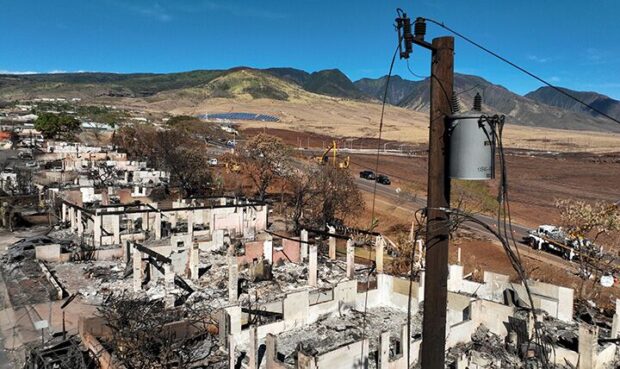Hawaii property owners are seizing on a legal shortcut used by fire victims in California to secure compensation from Hawaiian Electric Industries Inc. for damages following the fires that ravaged Maui.
The strategy, which doesn’t require proving negligence, helped push PG&E Corp., California’s largest utility, into bankruptcy and secured victims a $13.5 billion settlement in 2020.
While Hawaiian Electric and some analysts have said this approach has never been tested in Hawaii’s courts, some property owners are already pursuing it. Shares of Hawaiian Electric plunged 58 percent last week amid increasing investor concern that the utility could be held responsible for the fires.
Property owners’ success will hinge on a determination of whether the investor-owned Hawaiian Electric functions akin to a government agency because it supplies electricity to the public.
“It in fact may give us a more direct path to liability and damages,” said Graham LippSmith, a lawyer representing Maui fire victims in one of the suits. “Hawaiian Electric is a private utility, but it gets to operate as a quasi-governmental entity.”
Inverse Condemnation
Hawaiian Electric had used both private and public land to set up its power lines — some of which was destroyed by the fires. Even if the damage caused by the utility’s equipment was an accident, fire victims have the constitutional right to seek compensation for it if they can show that Hawaiian Electric was functioning like a government agency.
The legal argument, known as inverse condemnation, in which a property owner can sue the government for damages, is related to the constitutional process of eminent domain — the power of a government to take private property for public infrastructure projects and in return compensate the owner for it.
Using the legal shortcut, Maui property owners would be entitled to recover their losses without having to prove that the utility acted recklessly. In this case, Hawaiian Electric would be on the hook for damaged property.
‘No Precedent’
Hawaiian Electric said in a regulatory filing Friday that “there is no precedent in Hawaii applying inverse condemnation to a private party like an investor-owned utility.” Hawaiian Electric spokesman Darren Pai said the company doesn’t comment on pending litigation.
The blaze in the town of Lahaina damaged or destroyed more than 2,000 structures and killed more than 100 people. Investigations into the cause of the wildfire are still ongoing, and it’s not clear if the blame lies with Hawaiian Electric.
“We don’t necessarily need to show anyone did anything wrong, just that they were using the property in a way that created a danger and that the property was damaged from the use,” said LippSmith, the victims’ lawyer.
Still, it will be a “stretch” to convince a judge that the shortcut applies, said David Callies, a land use expert and recently retired professor at the University of Hawaii Law School.
“The key to inverse condemnation is it’s got to be a government agency that you’re suing,” he said. “As in PG&E, Hawaiian Electric is a private corporation that happens to be a public utility, which means its rates and some other things are regulated by government.”
Numerous lawsuits have been filed alleging that the utility’s power lines ignited the fires that destroyed much of Lahaina during an Aug. 8 storm. The most serious claims in these cases, including a complaint filed by LippSmith’s firm, go beyond property damage and blame Hawaiian Electric for wrongful deaths.
The potential liabilities could reach almost $4 billion if the utility is deemed negligent, according to investment research firm Capstone LLC. Hawaiian Electric Industries owns Hawaii’s main utility — which provides power to 95 percent of the state’s population and is regulated — and owns and operates the regional American Savings Bank FSB.
Hawaii became a U.S. state in 1959, more than 100 years after California. As a result, the island state is often viewed as a legal blank canvas, with its courts drawing from other states where legal doctrines have had more time to develop.
“Do they have inverse condemnation in Hawaii? Sure,” said Paul Starita, another lawyer whose firm is suing Hawaiian Electric. “Has it been used in a wildfire context? No, not that we’re aware of. And that’s why we haven’t pursued it.”
In recent years, California judges have grown more receptive to inverse condemnation as state investigations have pointed to utilities’ equipment and their lackluster management of vegetation as the source of the most destructive wildfires.
Like other states, Hawaii has a provision in its constitution that says “private property shall not be taken or damaged for public use without just compensation.”
That language has been the foundation for inverse condemnation to be used in a variety of disputes, said Shelley Ross Saxer, a law professor at Pepperdine University, adding that it makes sense for lawyers to borrow from California’s experience because wildfire cases are new to Hawaii.
Saxer said the devastating impact on Maui property owners boosts chances the theory will get a warm reception at Hawaii’s highest court.
“It’s a very sympathetic case on which to push this,” she said.





















 Why Insurance Telematics Integrations Fail
Why Insurance Telematics Integrations Fail  Rebuilding Negotiation Talent: Why This Skill Is Missing and How to Fix It
Rebuilding Negotiation Talent: Why This Skill Is Missing and How to Fix It  Aon Adds to List of Brokers Suing Howden US for Alleged Poaching, Theft
Aon Adds to List of Brokers Suing Howden US for Alleged Poaching, Theft  The Hardest Part of Innovation in Insurance Isn’t Technology; It’s Culture
The Hardest Part of Innovation in Insurance Isn’t Technology; It’s Culture 